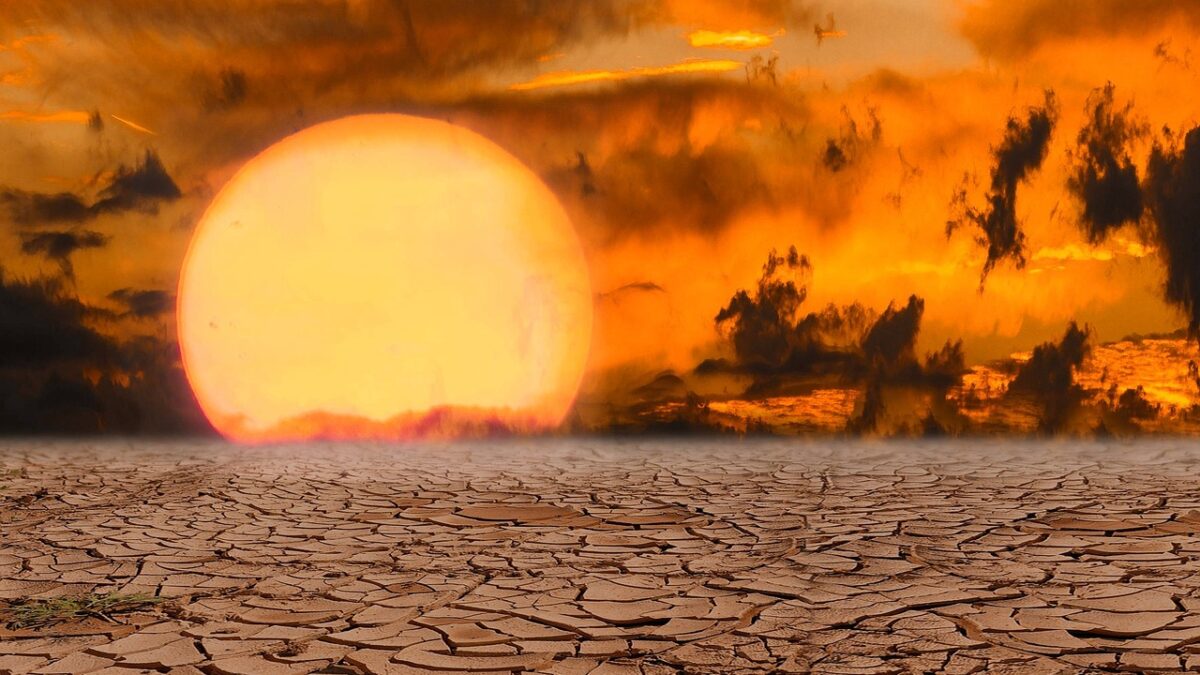Climate Change
Let's be Serious about it how much do you care or how much do you believe is it true or a political contriol game
.Earth formed around 4,5 billion years ago through the accretion of dust and gas in the solar nebuls , some believe is likely following the birth of the sun.This process involved the clumping together of particles, growing into larger bodies called planetesimals, which then collided and merged to form the planets, including Earth. A giant impact with a Mars-sized object, called Theia, is thought to have formed the Moon
Although the rocks that record the earliest parts of Earth’s history have been destroyed or deformed over time by more than four billion years of geology, scientists can use modern rocks, moon samples, and meteorites to figure out when and how the Earth and moon formed, and what they might once have looked like.
Earth grew to its final size through one last major collision with another Mars-sized object. This last collision, also known as the “moon-forming impact,” was so large that—in addition to adding lots of material to the Earth—there was enough energy to vaporize some of the rock and metal from both the proto-Earth and the impacting object. This vapor formed a disc around the Earth that eventually cooled and clumped together to become the moon.
We know this thanks to rigorous studies of meteorites and rock samples, including at the University of Chicago, in the 20th and 21st centuries.
Understanding how the Earth and moon formed is important for piecing together the history of the solar system and answering questions like how long planets take to form, what planets are made of, and what makes a planet suitable for life. This also guides planetary scientists in their search for other habitable (or inhabited!) worlds in our solar system and beyond!
How did the moon form?
Several different formation theories for the moon have been proposed by scientists, The story that is best supported by all the available data, however, is that the moon formed during a giant impact between the proto-Earth, and another protoplanet roughly the size of Mars, sometimes called “Theia.”
How do we know?
Samples of rock from the moon, brought to Earth by lunar meteorites and the Apollo moon landings, can be used to understand the history of the Moon and its relationship to the Earth through the chemistry of their minerals.
Planetary scientists like Prof. Nicolas Dauphas and Prof.
Andy Davis in the Geophysical Sciences Department at the University of Chicago make precise measurements of lunar samples to determine exactly what they’re made of, and identify the chemical fingerprints of different geological processes like the melting and mixing of rocks and the evaporation of gasses.
The first big clue about where the moon came from comes from oxygen. Oxygen, like many other elements, is able to exist in multiple forms, known as isotopes.
Different types of meteorites coming from the asteroids left over in the solar system after planet formation have different proportions of each of these oxygen isotopes. So, by measuring the oxygen isotopes of a given planet, planetary scientists can calculate the different types of asteroid that collided to form the planet. Lunar samples have a very similar oxygen isotope makeup to the Earth.
Formation
When the solar system settled into its current layout about 4.5 billion years ago, Earth formed when gravity pulled swirling gas and dust in to become the third planet from the Sun. Like its fellow terrestrial planets, Earth has a central core, a rocky mantle, and a solid crust.
Structure
Earth is composed of four main layers, starting with an inner core at the planet’s center, enveloped by the outer core, mantle, and crust.
The inner core is a solid sphere made of iron and nickel metals about 759 miles (1,221 kilometers) in radius. There the temperature is as high as 9,800 degrees Fahrenheit (5,400 degrees Celsius). Surrounding the inner core is the outer core. This layer is about 1,400 miles (2,300 kilometers) thick, made of iron and nickel fluids.
In between the outer core and crust is the mantle, the thickest layer. This hot, viscous mixture of molten rock is about 1,800 miles (2,900 kilometers) thick and has the consistency of caramel. The outermost layer, Earth’s crust, goes about 19 miles (30 kilometers) deep on average on land. At the bottom of the ocean, the crust is thinner and extends about 3 miles (5 kilometers) from the seafloor to the top of the mantle.
Surface
Like Mars and Venus, Earth has volcanoes, mountains, and valleys. Earth’s lithosphere, which includes the crust (both continental and oceanic) and the upper mantle, is divided into huge plates that are constantly moving. For example, the North American plate moves west over the Pacific Ocean basin, roughly at a rate equal to the growth of our fingernails. Earthquakes result when plates grind past one another, ride up over one another, collide to make mountains, or split and separate.
Earth’s global ocean, which covers nearly 70% of the planet’s surface, has an average depth of about 2.5 miles (4 kilometers) and contains 97% of Earth’s water. Almost all of Earth’s volcanoes are hidden under these oceans. Hawaii’s Mauna Kea volcano is taller from base to summit than Mount Everest, but most of it is underwater. Earth’s longest mountain range is also underwater, at the bottom of the Arctic and Atlantic oceans. It is four times longer than the Andes, Rockies and Himalayas combined.
Atmosphere
Near the surface, Earth has an atmosphere that consists of 78% nitrogen, 21% oxygen, and 1% other gases such as argon, carbon dioxide, and neon. The atmosphere affects Earth’s long-term climate and short-term local weather and shields us from much of the harmful radiation coming from the Sun. It also protects us from meteoroids, most of which burn up in the atmosphere, seen as meteors in the night sky, before they can strike the surface as meteorites.
Magnetosphere
Our planet’s rapid rotation and molten nickel-iron core give rise to a magnetic field, which the solar wind distorts into a teardrop shape in space. (The solar wind is a stream of charged particles continuously ejected from the Sun.) When charged particles from the solar wind become trapped in Earth’s magnetic field, they collide with air molecules above our planet’s magnetic poles. These air molecules then begin to glow and cause aurorae, or the northern and southern lights.
The magnetic field is what causes compass needles to point to the North Pole regardless of which way you turn. But the magnetic polarity of Earth can change, flipping the direction of the magnetic field. The geologic record tells scientists that a magnetic reversal takes place about every 400,000 years on average, but the timing is very irregular. As far as we know, such a magnetic reversal doesn’t cause any harm to life on Earth, and a reversal is very unlikely to happen for at least another thousand years. But when it does happen, compass needles are likely to point in many different directions for a few centuries while the switch is being made. And after the switch is completed, they will all point south instead of north
Thawing the freezer
Between 600 and 800 million years ago—a period of time geologists call the Neoproterozoic—evidence suggests the Earth underwent an ice age so cold that ice sheets not only capped the polar latitudes, but may have extended all the way to sea level near the equator.
Reflecting ever more sunlight back into space as they expanded, the ice sheets cooled the climate and reinforced their own growth. Obviously, the Earth didn’t remain stuck in the freezer, so how did the planet thaw?
Even while ice sheets covered more and more of Earth’s surface, tectonic plates continued to drift and collide, so volcanic activity also continued. Volcanoes emit the greenhouse gas carbon dioxide.
At various times in Earth’s history, continental-scale expanses of magma—known as large igneous provinces—may have released much greater quantities of greenhouse gases than today’s volcanoes.
In our current, mostly ice-free world, the natural weathering of silicate rock by rainfall consumes carbon dioxide over geologic time scales of tens to hundreds of thousands of years. During the frigid conditions of the Neoproterozoic, rainfall became rare, and most rocks were covered with ice.
With seismic activity churning out carbon dioxide and little or no rainfall to weather rocks and consume the greenhouse gas, temperatures climbed, unabated. Remarkably, our planet may have experienced some of its hottest temperatures sandwiched between some of its coldest temperatures.
Hasn’t Earth warmed and cooled naturally throughout history?
Yes. Earth has experienced cold periods (informally referred to as “ice ages,” or “glacials”) and warm periods (“interglacials”) on roughly 100,000-year cycles for at least the last 1 million years. The last of these ice age glaciations peaked* around 20,000 years ago.
Over the course of these cycles, global average temperatures warmed or cooled anywhere from 3° to perhaps as much as 8° Celsius (5°-15° Fahrenheit). It was partly through their attempts to understand what caused and ended previous ice ages that climate scientists came to understand the dominant role that carbon dioxide plays in Earth’s climate system, and the primary role that human-produced carbon dioxide is playing in current global warming.
Over at least the past million years, glacial and interglacial cycles have been triggered by variations in how much sunlight reaches the Northern Hemisphere in the summer, which are driven by small variations in the geometry of Earth’s axis and its orbit around the Sun. But these fluctuations in sunlight aren’t enough on their own to bring about full-blown ice ages and interglacials. They trigger several feedback loops that amplify the original warming or cooling. During an interglacial,
- sea ice and snow retreat, reducing the amount of sunlight the Earth reflects;
- warming increases atmospheric water vapor, which is a powerful greenhouse gas;
- permafrost thaws and decomposes, releasing more methane and carbon dioxide; and
- the ocean warms and releases dissolved carbon dioxide, which traps even more heat.
Like nothing we’ve experienced
Earth’s hottest periods—the Hadean, the late Neoproterozoic, the Cretaceous Hot Greenhouse, the PETM—all occurred millions of years before humans existed. That doesn’t mean we aren’t warming the planet now. In fact, studying past hothouse periods confirms the major role carbon dioxide plays in heating the Earth–no matter where it comes from.
Since 1800, carbon dioxide has risen 100-200 times as fast as when the Earth thawed out of its most recent glacial period between 17,500 and 11,500 years ago. Since 1850, global surface temperatures have risen roughly 0.11°F (0.06°C) per decade. Since 1982, they have risen 0.36°F (0.20°C) per decade. Earth’s fossil record links sudden climate change to extinction, for instance in marine invertebrates and marine mammals. Humans won’t likely go extinct, but losing the climate stability that has persisted throughout the entire history of civilization will mean unprecedented adaptation challenges: sea level rise and loss of coastal infrastructure, shifts in regional climate that affect food production, loss of dependable water supplies, more floods and wildfires, and an increased spread of infectious diseases.
No people lived on Earth for most of its history; we played no part in the planet’s hothouse conditions of the ancient past. But the planet’s history shows us that carbon dioxide has a strong influence on climate, and that rapid climate change causes major dislocation to animals and plants. We can learn from Earth’s history how our climate system works. These lessons from the past make it clear that we are now the ones changing global climate. Our role is undeniable, but so is our ability to change the future in ways that will make life better for people and other living things in generations to come.
How and when did the early Earth form?
Scientists now think the Earth’s story began around 4.6 billion years ago in a disk-shaped cloud of dust and gas rotating around the early sun, made up of material left behind after the sun’s formation.
Within this disk, gas and dust particles of different sizes orbited the sun at slightly different speeds, allowing them to bump into each other and stick together. Eventually, they grew from tiny dust grains into boulders, then into larger “planetesimals” that ranged from miles to hundreds of miles in diameter.
Because these planetesimals were larger than the boulders, they had strong enough gravity to pull neighboring planetesimals out of orbits and absorb them through collisions, enabling some planetesimals to grow bigger and bigger until they reached thousands of miles in diameter—about the size of the moon and Mars.
How do we know?
The key is meteorites. Meteorites bring many different types of material from all over the solar system to Earth where scientists can study them. These materials include chondrules—tiny pieces of dust and rock that have survived from before the planets formed—and pieces of asteroids and planetesimals left behind by the planet-building process. Radioactive elements like uranium and hafnium are trapped inside the minerals that make up these objects when they form, which allows planetary scientists to tell how old they are.
Using these measurements, and simulations of the physics of dust and planetesimal collisions, planetary scientists and astronomers have established that the dust-to-protoplanet process takes tens of millions of years.
But the final stage of planet formation in our solar system may have taken much longer – up to a hundred million years or so. This was not only the last major addition of material to the Earth, but also the event that formed the moon—and it’s one of the most debated parts of the story
What did the early Earth look like?
After the moon-forming impact, Earth was a very different planet from the world we see today! Where the present-day Earth has oceans covering much of its surface, the early Earth was covered in a magma ocean – a layer of molten rock hundreds of miles deep that was melted by the energy released during the collision. Any water present would only exist as water vapor in the atmosphere.
If that wasn’t enough, the early sun was also far more active than it is today, blasting the entire solar system with UV radiation energetic enough to evaporate entire atmospheres.
Over time, after the magma ocean cooled enough to form a solid surface, Earth’s atmosphere was replenished by volcanic eruptions, as well as water and other gasses delivered by comets and meteorites crashing into the surface.
This was also the first step towards our planet developing plate tectonics. Plate tectonics describes the giant “plates” of crust that slowly move around Earth’s surface over hundreds of millions of years; it not only produces new rocks at volcanoes where the plates are moving apart, but can also recycle rocks from the Earth’s surface and atmosphere back into the interior where plates are coming together. This process – known as “subduction” – carries rocks, water, and carbon dioxide trapped in minerals back into the Earth’s interior where they can drive future volcanic eruptions, continuing the plate tectonic cycle.
Some planetary scientists believe that plate tectonics is essential for a planet to develop life. This is because the repeated production and destruction of crust by plate tectonics both releases carbon dioxide to the atmosphere and removes it, helping keep temperatures on Earth similar (and comfortable for microbes, fish, and humans!) over billions of years.
Whether a planet has plate tectonics is much more complicated than just having a solid surface, though, and might also depend on the types and amount of different asteroids, planetesimals, and protoplanets that the Earth is made of because of the way different chemicals and minerals can change how planet interiors behave over billions of years
Size and Distance
With an equatorial diameter of 7926 miles (12,760 kilometers), Earth is the biggest of the terrestrial planets and the fifth largest planet in our solar system.
From an average distance of 93 million miles (150 million kilometers), Earth is exactly one astronomical unit away from the Sun because one astronomical unit (abbreviated as AU), is the distance from the Sun to Earth. This unit provides an easy way to quickly compare planets’ distances from the Sun.
It takes about eight minutes for light from the Sun to reach our planet.
Orbit and Rotation
As Earth orbits the Sun, it completes one rotation every 23.9 hours. It takes 365.25 days to complete one trip around the Sun. That extra quarter of a day presents a challenge to our calendar system, which counts one year as 365 days. To keep our yearly calendars consistent with our orbit around the Sun, every four years we add one day. That day is called a leap day, and the year it’s added to is called a leap year.
Earth’s axis of rotation is tilted 23.4 degrees with respect to the plane of Earth’s orbit around the Sun. This tilt causes our yearly cycle of seasons. During part of the year, the northern hemisphere is tilted toward the Sun, and the southern hemisphere is tilted away. With the Sun higher in the sky, solar heating is greater in the north producing summer there. Less direct solar heating produces winter in the south. Six months later, the situation is reversed. When spring and fall begin, both hemispheres receive roughly equal amounts of heat from the Sun.
Moons
Earth is the only planet that has a single moon. Our Moon is the brightest and most familiar object in the night sky. In many ways, the Moon is responsible for making Earth such a great home. It stabilizes our planet’s wobble, which has made the climate less variable over thousands of years.
Earth sometimes temporarily hosts orbiting asteroids or large rocks. They are typically trapped by Earth’s gravity for a few months or years before returning to an orbit around the Sun. Some asteroids will be in a long “dance” with Earth as both orbit the Sun.
Some moons are bits of rock that were captured by a planet’s gravity, but our Moon is likely the result of a collision billions of years ago. When Earth was a young planet, a large chunk of rock smashed into it, displacing a portion of Earth’s interior. The resulting chunks clumped together and formed our Moon. With a radius of 1,080 miles (1,738 kilometers), the Moon is the fifth largest moon in our solar system (after Ganymede, Titan, Callisto, and Io).
The Moon is an average of 238,855 miles (384,400 kilometers) away from Earth. That means 30 Earth-sized planets could fit in between Earth and its Moon.
History of hot
Temperature records from thermometers and weather stations exist only for a tiny portion of our planet’s 4.54-billion-year-long life. By studying indirect clues—the chemical and structural signatures of rocks, fossils, and crystals, ocean sediments, fossilized reefs, tree rings, and ice cores—however, scientists can infer past temperatures.
None of these techniques help with the very early Earth. During the time known as the Hadean (yes, because it was like Hades), Earth’s collisions with other large planetesimals in our young solar system—including a Mars-sized one whose impact with Earth likely created the Moon—would have melted and vaporized most rock at the surface. Because no rocks on Earth have survived from so long ago, scientists have estimated early Earth conditions based on observations of the Moon and on astronomical models. Following the collision that spawned the Moon, the planet was estimated to have been around 2,300 Kelvin (3,680°F).
Even after collisions stopped, and the planet had tens of millions of years to cool, surface temperatures were likely more than 400° Fahrenheit. Zircon crystals from Australia, only about 150 million years younger than the Earth itself, hint that our planet may have cooled faster than scientists previously thought. Still, in its infancy, Earth would have experienced temperatures far higher than we humans could possibly survive.
But suppose we exclude the violent and scorching years when Earth first formed. When else has Earth’s surface sweltered?
The tropical Arctic
A Smithsonian Institution project has tried to reconstruct temperatures for the Phanerozoic Eon, or roughly the last half a billion years. Preliminary results released in 2019 showed warm temperatures dominating most of that time, with global temperatures repeatedly rising above 80°F and even 90°F—much too warm for ice sheets or perennial sea ice. About 250 million years ago, around the equator of the supercontinent Pangea, deserts predominated, thanks to a combination of heat and aridity.
Geologists and paleontologists have found that in the last 100 million years, global temperatures have peaked twice. One spike was the Cretaceous Hot Greenhouse roughly 92 million years ago, about 25 million years before Earth’s last dinosaurs went extinct. A 2024 paleoclimate reconstruction named PhanDA (Phanerozoic Data Assimilation) found a strong correlation between temperature and carbon dioxide during the Paleozoic (from the start of the reconstruction at 485 million years ago through 250 million years ago) and the Cenozoic (the last 65 million years) but did not find a similarly strong link during the age of the dinosaurs. So, the precise cause of the Cretaceous Hot Greenhouse will need continued research, but the fossils indicate a very warm planet. Temperatures were so high that champsosaurs (crocodile-like reptiles) lived as far north as the Canadian Arctic, and warm-temperature forests thrived near the South Pole.
Another hothouse period was the Paleocene-Eocene Thermal Maximum (PETM) about 56 million years ago. During much of the Paleocene and early Eocene, the poles were free of ice caps, and palm trees and crocodiles lived above the Arctic Circle. Though not quite as hot as the Cretaceous hothouse, the PETM saw average global surface temperature rise about 6°C (11°F) in less than 10 millennia. That figured among the fastest periods of warming observed in the geological record, but as the Smithsonian’s Scott Wing explains, continued high greenhouse gas emissions and the projected amount of warming they are likely to cause over the next few centuries could amount to roughly the same amount of warming at a rate 10 times faster.
During the PETM, the global mean temperature appears to have risen by as much as 5-8°C (9-14°F) to an average temperature as high as 34°C (93°F). (Again, today’s global average is shy of 60°F.) At roughly the same time, paleoclimate data like fossilized phytoplankton and ocean sediments record a massive release of carbon dioxide into the atmosphere, at least doubling or possibly even quadrupling the background concentrations.
It is still uncertain where all the carbon dioxide came from and what the exact sequence of events was. Scientists have considered the drying up of large inland seas, volcanic activity, thawing permafrost, release of methane from warming ocean sediments, huge wildfires, and even—briefly—a comet. In recent years, evidence has emerged that huge volcanic eruptions occurred in North America at the time of the PETM, and these volcanoes were a likely source of at least some of the carbon dioxide.
References
British Geological Survey. Impacts of climate change. Accessed February 7, 2022.
The Cenozoic CO2 Proxy Integration Project (CenCO2PIP) Consortium. (2023). Toward a Cenozoic history of atmospheric CO2. 382(6675), eadi5177.
Engber, D. (2012, July 5). What’s the hottest the Earth has ever gotten?
Eurekalert. (2023, December 7). Geoscientists map changes in atmospheric CO2 over past 66 million years. Accessed December 24, 2023.
Glavovic, B.C., Dawson, R., Chow, W., Garschagen, M., Haasnoot, M., Singh, C., Thomas, A. (2022).: Cross-Chapter Paper 2: Cities and Settlements by the Sea. In: Climate Change 2022: Impacts, Adaptation and Vulnerability. Contribution of Working Group II to the Sixth Assessment Report of the Intergovernmental Panel on Climate Change.
.






